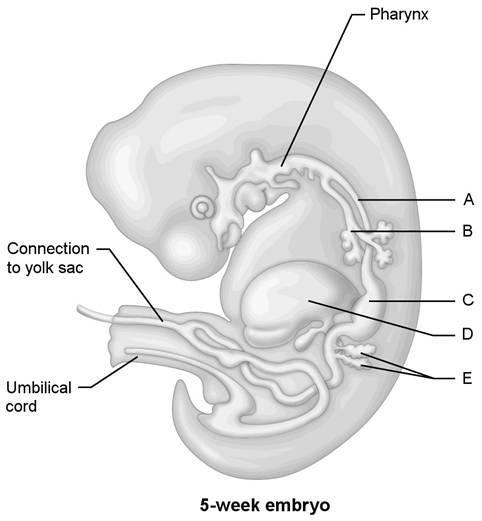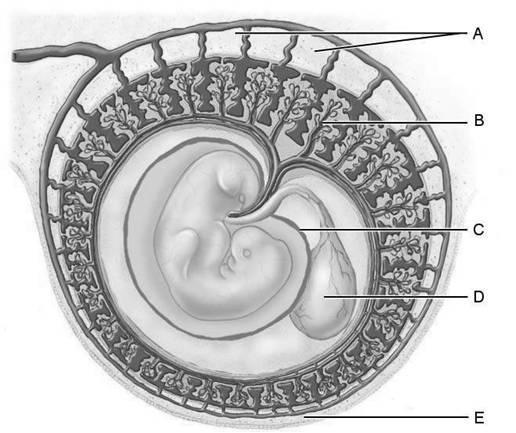
1) Liver.
1. Answer: D

Esophagus
2. Answer: A

3) Trachea.
3. Answer: B

4) Stomach.
4. Answer: C

5) Pancreas.
5. Answer: E

6) Protective water-filled sac surrounding the embryo.
6. Answer: Amnion

7) Extra-embryonic membrane that develops from the trophoblast and some extra-embryonic mesoderm, and forms part of the placenta.
7. Answer: Chorionic villus

8) Site of early blood cell production, and forms part of the gut (digestive tube).
8. Answer: Yolk sac

9) The part of the endometrium destined to be a part of the placenta.
9. Answer: Decidua basalis

10) The part of the endometrium that surrounds the uterine cavity face of the implanted embryo.
10. Answer: Decidua capsularis
Match the following
A) Capacitation
B) Fertilization
C) Implantation
D) Gastrulation
E) Cleavage
11) Leads to the development of a morula and then a blastocyst.
E) Cleavage
A) Capacitation
B) Fertilization
C) Implantation
D)
Gastrulation
E) Cleavage
12) Embedding of the blastocyst in the uterine wall.
C) Implantation
A) Capacitation
B) Fertilization
C) Implantation
D)
Gastrulation
E) Cleavage
13) Leads to the formation of the first cell of the new individual.
B) Fertilization
A) Capacitation
B) Fertilization
C) Implantation
D)
Gastrulation
E) Cleavage
14) Leads to the establishment of the three primary germ layers.
D) Gastrulation
A) Capacitation
B) Fertilization
C) Implantation
D)
Gastrulation
E) Cleavage
15) Leads to enhancement of sperm motilityand increasing membrane fragility to enable enzyme release from acrosomes.
A) Capacitation
True and False. a=True b=False
Conceptus is a term used to describe the developing human offspring.
a. True
The period from fertilization through week eight is called the embryonic period.
a. True
Fertilization occurs while the egg is still in the ovarian follicle.
b. False
Freshly deposited sperm are not capable of penetrating an oocyte.
a. True
By 72 hours after fertilization, the egg has divided into more than 160 cells and is called the morula.
b. False
Implantation begins six to seven days after ovulation.
a. True
A pregnancy test involves antibodies that detect GH levels in a woman's blood or urine.
b. False
The body systems of the developing embryo are present in at least rudimentary form at eight weeks.
a. True
Of the three germ layers, the mesoderm forms the most body parts.
a. True
A pregnant woman urinates more often than usual because the uterus compresses the bladder, and she must also dispose of fetal metabolic wastes.
a. True
The "fluid-filled, hollow ball of cells" stage of development is the blastocyst.
a, True
The embryonic stage lasts until the end of the eighth week.
a. True
The embryo is directly enclosed in and protected by the amnion.
a. True
In fetal circulation, one way in which blood bypasses the nonaerated lungs is by way of the foramen ovale.
a. True
An episiotomy is an incision made to widen the vaginal orifice, aiding fetal expulsion.
a. True
The placenta and its attached fetal membranes are collectively called the afterbirth.
a. True
Human placental lactogen initiates labor.
b. False
18) Surfactant production in premature infants is rarely a factor in providing normal respiratory activity.
b. False
A blastocyst is a hollow ball of cells, while the morula is a solid ball of cells.
a. True
A zygote is usually formed within the uterus.
b. FALSE
Fill-in-the-Blank/Short Answer Questions
The first "milk" the mother produces is called ________.
Answer: colostrum
As the newborn suckles, the mother's pituitary produces ________ to assist in producing milk.
Answer: prolactin
The act of giving birth is called ________.
Answer: parturition
After the egg is fertilized, it is called a(n) ________.
Answer: zygote
The ________ cells of the blastocyst will take part in placental formation.
Answer: trophoblast
The ________ stage of development is the first in which all three germ layers of tissue are evident.
Answer: gastrula
________ is a tissue with star-shaped cells that are free to migrate widely throughout the embryo.
Answer: Mesenchyme
Neural tissue develops from the ________.
Answer: ectoderm
Which cells invade the endometrium, digesting the uterine cells they contact, so that implantation of the blastocyst can occur?
Answer: syncytial trophoblast cells
What embryonic structure is the structural base for the umbilical cord?
Answer: allantois
Explain what triggers a baby’s first breath.
Answer: A buildup of carbon dioxide in the baby’s blood once the carbon dioxide is not being removed by the placenta causes acidosis. This excites respiratory control centers in the baby’s brain and triggers the first inspiration.
The first axial support for the embryo is called the ________.
Answer: notochord
At what time in the pregnancy is the placenta fully prepared to fulfill the needs of the developing fetus?
Answer: The placenta is fully formed and functional as a nutritive, respiratory, excretory, and endocrine organ by the end of the third month of pregnancy.
Briefly describe the events leading to the implantation of the blastocyst in the uterus, including how it is nourished.
Answer: The blastocyst floats freely in the uterine cavity for three or four days, during which time it is nourished by uterine secretions. Six days after ovulation, implantation begins. The trophoblast determines the readiness of the endometrium for implantation. If the mucosa is prepared for implantation, the blastocyst becomes embedded high in the uterus.
How are the metabolic needs of the implanted embryo provided for?
Answer: Initially, the implanted embryo obtains nutrition by digesting the endometrial cells, but by the second month, the placenta is providing all the nourishment and oxygen the embryo requires. The placenta is also responsible for disposing of embryonic metabolic wastes.
Describe the events of the oocyte from sperm penetration to first cleavage.
Answer: After sperm penetration, the oocyte completes meiosis II and releases the second polar body. The two nuclei swell into pronuclei and join each other to form a zygote. The cell then undergoes its first mitosis and cell division to form two daughter cells.
Define Braxton-Hicks contractions.
Answer: Braxton-Hicks contractions are the weak, irregular uterine contractions resulting from the increase in estrogen production. Estrogen causes oxytocin receptors to form on the myometrial cells of the uterus and antagonizes progesterone's quieting influence on the uterine muscle. As a result, the myometrium becomes increasingly irritable, resulting in weak, irregular contractions.
List four factors that help to precipitate parturition.
Answer: Four factors that help to precipitate parturition include: (1) estrogen peaks to its highest levels in the mother's blood, causing irregular uterine contractions due to oxytocin and negation of progesterone's influence on the uterine muscle; (2) prostaglandins are stimulated by the increase in oxytocin to act as uterine muscle stimulants; (3) increasing emotional and physical stressors activate the mother’s hypothalamus, which signals oxytocin release; and (4) certain cells of the fetus begin to produce oxytocin, which in turn acts on the placenta, stimulating production and release of prostaglandins.
Briefly describe the physiological changes occurring in the mother during pregnancy.
Answer: Many women suffer nausea until their systems become adjusted to elevated levels of estrogen and progesterone. Heartburn is common due to displacement of the esophagus and crowding of the stomach by the growing fetus in the uterus. Additional wastes from fetal metabolism cause the production of more urine. Due to pressure on the bladder by the uterus, urination is more frequent. Tidal volume increases during pregnancy, as does respiratory rate. Residual volume decreases and many women exhibit dyspnea. Total body water rises, acting as a safeguard against blood loss during birth. Blood volume increases, blood pressure and pulse rise, and cardiac output increases.
Describe the events allowing monospermy.
Answer: A sperm entering the oocyte causes ionic calcium to be released into the oocyte cytoplasm, activating the oocyte and preparing it for cell division. This also causes the cortical granules to spill their contents into the extracellular space beneath the zona pellucida. Enzymes from the cortical granulus destroy sperm receptors, preventing further sperm entry. This spilled material binds with water, and as it swells, detaches all sperm still in contact with the oocyte membrane.
When do we begin to call the developing individual a fetus rather than an embryo?
Answer: We begin to call the developing individual a fetus at the beginning of the ninth week.